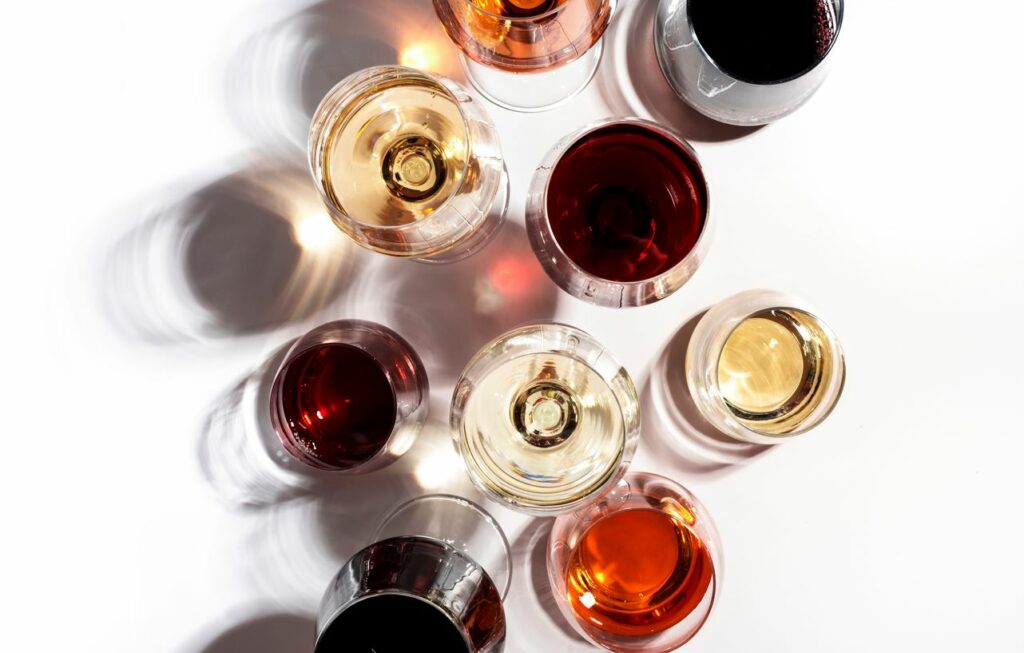You will find sulfites in many wines, as they are used extensively as a preservative. Including sulfites in wine keeps the taste fresh for longer and to avoid it turning into vinegar. Wine lovers complain of adverse effects as a result of ingesting them such as wine headaches.
It is believed that sulfur dioxide has been added when making wine since the ancient Roman period, where it was added to halt the fermentation and prevent the wine from becoming vinegar. Sulfites are formed during the fermentation process therefore no absolute sulfite free wines are available.
What are sulfites?
These are chemical compounds that contain a sulfite ion, also referred to as sulfur dioxide. They are naturally occurring compounds found in black tea, dried fruit, eggs, fermented foods, and peanuts.
Commercially, extra sulfites are added to dried foods, dried fruits, juice, jelly, Jell-O, soda, sausages, and dried or pickled produce.

In wine, they are used to reduce the amount of oxidation that occurs. This is when the compounds in the wine react with oxygen in the air, the same process that makes apples turn brown when exposed to the air.
Sulfites are antimicrobial agents. They can slow and prevent bacterial growth, extending the shelf life of the products. There are specific types of sulfites, such as potassium metabisulfite, that are used to sanitize wine-making equipment and barrels.
Why would you want to remove them?
In wine, they are used to reduce the amount of oxidation that occurs. This side reaction takes place when the compounds in the wine react with oxygen in the air. It is the same process that makes apples turn brown when exposed to the air.
Sulfites are antimicrobial agents. They can slow and prevent bacterial and yeast growth, extending the shelf life of the products. There are specific types of sulfites, such as potassium metabisulfite, that are used to sanitize wine-making equipment and barrels.
Why would you want to remove them?
The risk of experiencing side effects from consuming sulfites when you enjoy red wines is low, but not unheard of. In 1986, the Food and Drug Administration (FDA) officially identified sulfites as an allergen. After this point, some food safety legislation was passed stating that sulfites must be disclosed on wine labels if the levels exceeded 10 mg per liter.
According to data from the FDA, about 1% of the US population is sensitive to sulfites. There is a weak link between sulfite sensitivity and asthma. If you suffer from both of these conditions there is a chance that wine can irritate your respiratory tract which can cause issues with breathing.

There is also some evidence to suggest that people with sulfite sensitivities will experience headaches after drinking wine. This has not been proven conclusively as there are other compounds such as histamines, alcohol, flavonoids, and tyramine found in wine which can cause headaches too. Sulfites in wine can leave a bitter taste in wine which can be easily noticed when you enjoy wine.
Wine headaches are a headache often caused by drinking not enough water when you enjoy wine as the alcohol dehydrates your body.
There are other symptoms that have been reported as a result of consuming sulfites. These include diarrhea, stomach aches, bloating, joint swelling, hives, anaphylaxis, and in rare cases, death.

So what’s this magical way to remove them?
The different commercially available methods use different techniques to remove sulfite preservatives from wine to allow you to enjoy one glass of wine, one bottle, or the whole bottle.
Liquid wine purifiers mostly contain very diluted food grade hydrogen peroxide with natural egg white powder and soja lecithin as active ingredient. Hydrogen peroxide oxidizes the sulfites. The egg white powder and soja lecithin absorb the formed sulfates and keep them in solution in your glass. The sulfites are converted into hydrogen sulfate.
Pros:
- easy to use and cheap
- vegan variants available without egg white powder
- You can use it per glass and not the entire bottle
Cons:
- Contains hydrogen peroxide
- If you add too much of the purification liquid to your wine glass it will react with the polyphenols in wine and may alter the taste
How to remove sulfites from wine chemical free?
Wine purifiers which use purification bags or exchangeable filters apply polymeric resins so called ion exchange resins to replace the sulfites with harmless substances which don`t alter the taste.
Alternatively dried algue in teabags are used to remove sulfites. They act as a wine purifier by taking up the sulfites. Next time you drink wine this is a great way to avoid a red wine headache.
Pros:
- easy to use wine purifier
- do not alter the natural flavor
- chemical free
Cons:
- Create a lot of waste
Wine aerators aerate wine by mixing the wine with oxygen. They accelerate the oxidation process to partially oxidise the sulfites and to liberate wine aromas.
Pros:
- easy to use
- can be re-used
- leave the wine in its natural state
- can reduce sulfites from wine
- Improve the wines taste
Cons:
- Price
- May not oxidise all sulfites
Which wines have the least sulfites?
When it comes to the sulfite content in wines, different varieties can vary significantly. The level of sulfites added in wineries in the winemaking process depends on the grape quality. Generally, white wines tend to contain higher levels of sulfites compared to reds.

This is because whites typically undergo more processing and require additional preservation agents due to their lighter and more delicate nature. However, it’s important to note that sparkling wines, such as champagne or prosecco, often have even higher sulfite levels than both red and white varieties. The effervescence in these types of wine typically requires additional sulfites for stabilization.
For those seeking lower sulfite options, organic wines are becoming increasingly popular. They are made from grapes grown without synthetic pesticides, added sulfites or chemical fertilizers, resulting in reduced overall sulfur dioxide levels compared to conventionally produced wines. This makes them a great choice for individuals with sensitivities to sulfites. They are not completely sulfite free as sulfites are formed during the fermentation process.
Ullo Wine Purifier
There are a multitude of ways to remove sulfites from wine. One of the most convenient, and modern methods, is to use a product called Üllo. This product is available on Amazon for $60 and is a game-changer in the world of wine purification.
The product sits on the top of your wine glass and the alcohol is poured through it. As the wine passes through the product, it is aerated and the sulfites are extracted from only product.

Wine Drops
Drop It also makes some wine drops that can be found on Amazon for $19.99 for a pack of 2 bottles. This is enough to remove the sulfites from 55 glasses (7-9 bottles) of wine and is said to work in just 20 seconds. It is said to be effective at removing sulfites in all types of wine and will remove some of the tannins too.
PureWine wine wand purifiers
Another option is to purchase wine wand purifiers from PureWine. These are disposable, single-use wands that are placed into your glass of wine. A pack of 72 can be found on Amazon for $154.99.
These wands will remove both the sulfites and histamines from your glass of wine. They also aerate the wine and will purify it in just 3 minutes. The manufacturers also claim that you can use this product to refresh wine that has been left open and allowed to oxidize.
PureWine also makes a product known as a wave bottle spout pourer. This can be found for $19.99 on Amazon and is a single-usewinemaking product
The spout is inserted into the neck of a wine bottle and will filter the histamines and sulfites from your wine before it even enters your glass. As with the purifiers, the spout will aerate and refresh the wine too.
SO2Go
This product is a spray manufactured in Australia. It is available for $17.95 on Amazon which will remove sulfites from 40 glasses of wine. To use this product, you simply need to spray 2 squirts into a glass of wine and swirl it around. This product will help to neutralize the sulfites found in wine.
Wine Balanced
You can also purchase wine filter sachets from a company called Wine Balanced. A package of 18 sachets can be purchased on Amazon for $17.95.
The sachets resemble a teabag and are made from organic and natural ingredients sourced from the Black Sea in Norway. They claim to remove sulfites and tannins from the wine immediately. The dried algue take up the sulfites from the wine glass and maintain the natural flavor of the wine.
Wine Sensitive Filter Sulfite Remover
The Wine Sensitive Filter Sulfite Remover has revolutionized the way wine enthusiasts enjoy their favorite beverages. With its innovative technology, this filter effectively eliminates sulfites from wine, allowing wine drinkers and individuals with sensitivities to indulge without worry.
What’s more, this filter doesn’t alter the taste or quality of the wine, maintaining its original flavors and aromas. This groundbreaking product opens up new possibilities for those who have previously had to avoid certain wines due to sulfite content, providing them with a newfound freedom to explore a wider variety of options.
Vintorio Wine Aerator
The Vintorio Wine Aerator is a game-changer for wine enthusiasts seeking to elevate their drinking experience. By enhancing the flavor and aroma of the wine, this innovative device accelerates the aeration process. With its sleek and practical design, the Vintorio Aerator effortlessly integrates into any wine-serving ritual, making it an essential tool for both novices and connoisseurs alike.
The Wave by PureWine: Wine Aerator and Filter
The Wave by PureWine revolutionizes the wine-drinking experience by combining the functions of a wine aerator and filter into one sleek device. Its unique design not only aerates the wine, enhancing its flavor and aroma, but also effectively removes sulfites through oxidation. This innovative approach allows wine enthusiasts to enjoy a smoother, purer taste without compromising on the integrity of other components of the wine.

